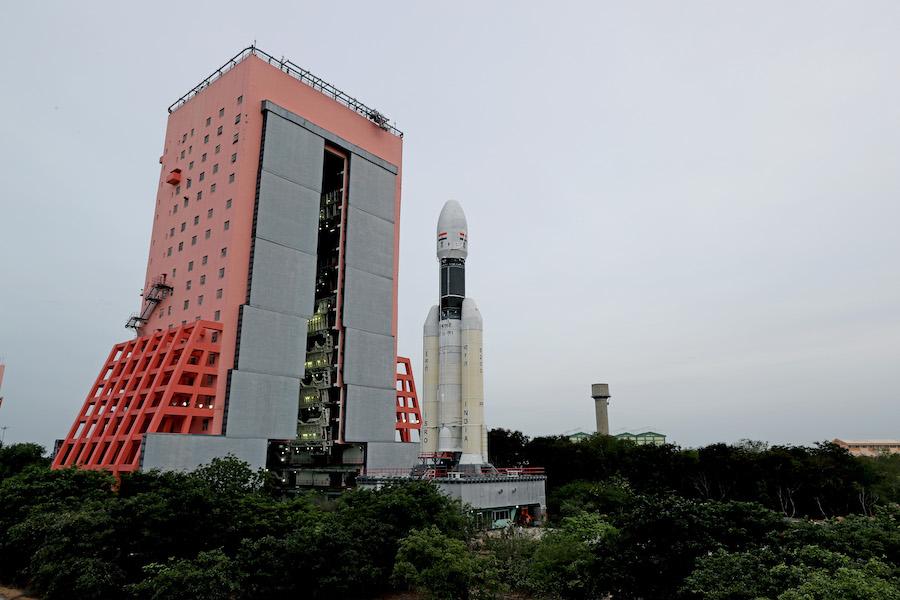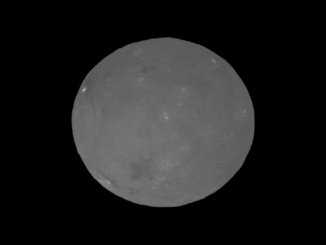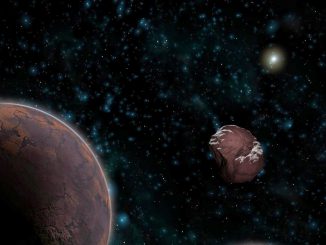
India’s ambitious $142 million Chandrayaan 2 moon mission, comprising a orbiter, lander and rover, is set for liftoff Sunday to begin a nearly two-month transit culminating in a touchdown near the lunar south pole in September.
The robotic science mission is awaiting liftoff aboard India’s Geosynchronous Satellite Launch Vehicle Mk.3, or GSLV Mk.3, rocket at 2121 GMT (5:21 p.m. EDT) Sunday from a spaceport on the Indian east coast.
If everything goes according to plan, the three-in-one spacecraft will arrive in orbit around the moon around Aug. 5, then detach the landing craft around Sept. 2 or 3 to begin lowering its altitude in preparation for a final descent to the lunar surface as soon as Sept. 6.
“We are landing at a place where nobody else has gone,” said K. Sivan, chairman of the Indian Space Research Organization.
Indian scientists are targeting landing of the Chandrayaan 2 lander at an unexplored site located on the near side of the moon at 70.9 degrees south latitude, closer to the moon’s south pole than any previous mission. The landing module is named Vikram for Vikram Sarabhai, the father of India’s space program, and will deploy the Pragyan rover, named for the Sanskrit word for “wisdom.”
The stationary lander and rover are designed to last 14 days — equivalent to half of a lunar day — until the sun sets at the landing site, robbing the vehicles of electrical power as temperatures plummet to near minus 300 degrees Fahrenheit (minus 183 degrees Celsius).
If the landing is successful, India will become the fourth nation to accomplish a controlled soft touchdown on the moon, following landings by the Soviet Union, the United States and China.
Clive Neal, a lunar scientist at the University of Notre Dame, said India’s space program “making great strides” after placing spacecraft into orbit around the moon and Mars in 2008 and 2013, respectively.
Chandrayaan 2 is a follow-up to India’s Chandrayaan 1 lunar orbiter, which made history by detecting water-bearing molecules at the moon’s poles, with the highest concentrations inside permanently-shadowed craters at the south pole.
“This proof of capability, the Chandryaaan 2 mission with the lander and the rover, is very ambitious,” Neal said in an interview with Spaceflight Now.
And Chandrayaan 2’s budget is a fraction of the development budget for NASA’s Lunar Reconnaissance Orbiter, which cost more than $500 million to build and launch in 2009.
“They’ve got a nice landing site picked out,” Neal said. “It looks pretty benign in terms of small craters and boulders. This would be a pathfinder for future landings in more challenging environments, and because it’s a new place (to explore) on the moon, there will be good science that comes out of it.”

China is the most recent country to join the elite group of nations with successful moon landing missions. China’s Chang’e 3 mission landed on the near side of the moon in 2013, and Chang’e 4 made the first soft landing on the far side of the moon in January.
Chang’e 4’s lander and rover are still operating, and if successful, the arrival of Chandrayaan 2 in September could mark the first time since the 1970s that two spacecraft have operated on the moon’s surface at the same time.
“This is very exciting, and I wish them well,” Neal said. “They’ve got a wealth of experiments that they’re carrying on the orbiter, the lander and the rover. It’s going to tell us some interesting things about the lunar surface at a location we haven’t been to.”
ISRO says the orbiter’s mission will last at least a year, taking high-resolution images and scanning the lunar surface with radar and spectral imagers to hunt for signs of water ice.
Officials originally designed the Chandrayaan 2 mission as a joint endeavor with Russia, which was to provide the landing module to fly to the moon with an Indian-made orbiter and rover. But Russia dropped out of the project after the failure of the Phobos-Grunt Mars probe in 2011, prompting the Indian government to make Chandrayaan 2 an all-Indian mission.
“This mission is not only ISRO’s mission,” Sivan said in a press briefing last month. “It is a mission of the entire country.”
Chandrayaan 2 will ride into space on top of a GSLV Mk.3 rocket, India’s most powerful launcher, from the Satish Dhawan Space Center on Sriharikota Island, located on the coast of the Bay of Bengal in southeastern India.
Making its third full-up flight, the 142-foot-tall (43.4-meter) launch vehicle will take off at 2:51 a.m. Indian Standard Time on Monday with some 2.2 million pounds of thrust from two solid-fueled boosters.

An air-lit core stage with two hydrazine-fueled Vikas engines and an upper stage with a hydrogen-fueled engine will send the Chandrayaan 2 mission into space. Separation of the Chandrayaan 2 spacecraft is scheduled at T+plus 16 minutes, 13 seconds.
Indian space program managers last year moved the Chandrayaan 2 launch from the less capable GSLV Mk.2 rocket to the GSLV Mk.3 after the spacecraft exceeded its original weight during development.
The orbiter, lander and rover together will weigh around 8,500 pounds — about 3,850 kilograms — at the time of launch. About one-third of that weight is propellant, according to Sivan.
The GSLV Mk.3 will haul the Chandrayaan 2 spacecraft into an elliptical transfer orbit around Earth, with a low altitude of 105 miles (170 kilometers) and a maximum distance from Earth of 24,270 miles (39,059 kilometers).
After separation from the GSLV Mk.3 launcher, Chandrayaan 2’s orbiter will extend a power-generating solar array wing and gear up for a series of orbit-raising burns before breaking free of the grip of Earth’s gravity and traveling to the moon.
Five engine burns over 16 days will nudge Chandrayaan 2’s orbit higher before a trans-lunar injection maneuver at the end of July sends the spacecraft on a five-day arcing trajectory to intercept the moon.
Another critical engine burn around Aug. 5 will place the Chandrayaan 2 spacecraft in an oval-shaped orbit around the moon — ranging between 93 miles (150 kilometers) and about 11,200 miles (18,000 kilometers) in altitude — followed by additional thruster firings to steer the probe into a circular 62-mile-high (100-kilometer) orbit by early September.
Then the Vikram lander will detach from the orbiter to begin descent maneuvers, ending with a 15-minute landing sequence from an altitude of about 100,000 feet (30 kilometers) on Sept. 6, according to ISRO.
“These 15 minutes are going to be the most terrifying moment for all of us,” Sivan said. “It is going to be a terrifying moment because … ISRO has never undertaken such a complex flight. This 15 minutes of flight is the most complex mission ISRO has ever undertaken.”

Five throttleable liquid-fueled engines will control the lander’s rate of descent, and a laser rangefinder will guide the spacecraft toward a landing zone in an ancient polar highlands region between two craters at approximately 70.9 degrees south latitude, and 22.8 degrees east longitude.
The Chandrayaan 2 spacecraft’s three components each carry a suite of scientific instruments:
- Orbiter
- Mass: 5,244 pounds (2,379 kilograms)
- Dimensions: 3.2 x 5.8 x 2.1 meters (10.5 x 19.0 x 6.9 feet)
- Power: 1,000 watts
- Description: The Chandrayaan 2 orbiter — designed for a one-year mission — carries eight scientific instruments, including a high-resolution stereo imaging camera, a dual-frequency synthetic aperture radar look for evidence of water ice at the lunar poles, an imaging infrared spectrometer to aid in the search for water, and sensors to study the moon’s tenuous atmosphere. The orbiter will also provide data relay services the Vikram lander.
- Vikram Lander
- Mass: 3,243 pounds (1,471 kilograms)
- Dimensions: 2.54 x 2.0 x 1.2 meters (8.33 x 6.6 x 3.9 feet)
- Power: 650 watts
- Description: The Vikram lander’s targeted touchdown zone is located in a highland region on the the near side of the moon at approximately 70.9 degrees south latitude, closer to the moon’s south pole than any previous lunar landing mission. Vikram will use five throttleable liquid-fueled engines to slow down for landing. The stationary landing craft carries a suite of multiple cameras and three science instruments, including a seismometer to listen for moonquakes, a thermal probe to reach a depth of up to 33 feet (10 meters) to measure the vertical temperature gradient in the lunar crust, sensors to investigate plasma near the moon’s surface, and a NASA-provided laser retroreflector array to help scientists locate the lander’s exact position on the moon. The Vikram lander is designed to last 14 days on the moon, equivalent to one lunar day.
- Pragyan Rover
- Mass: 59 pounds (27 kilograms)
- Dimensions: 0.9 x 0.75 x 0.85 meters (3.0 x 2.46 x 2.79 feet)
- Power: 50 watts
- Description: The solar-powered Pragyan rover has a range of up to 500 meters, or 1,640 feet, during its 14-day mission on the moon. The AI-enabled rover has six wheels and will relay science data and images through a radio link with the Vikram lander. Indian scientists installed an alpha particle X-ray spectrometer to measure the elemental composition of the rocks at the Chandrayaan 2 landing site, along with a laser-induced breakdown spectroscope. The Pragyan rover is named for the Sanskrit word for “wisdom.”
The lander’s targeted destination is roughly 220 miles (350 kilometers) from the rim of the South Pole-Aitken basin, a region scientists believe is one of the most ancient impact sites in the solar system, created when a large asteroid or comet struck the moon billions of years ago.
For the first time, Chandrayaan 2’s rover could examine ancient material in the lunar crust ejected during the colossal collision that created the South Pole-Aitken basin, providing data that could yield clues about the solar system’s chaotic early history.
China’s Chang’e 4 mission, landed on the far side of the moon in January, is exploring the mid-latitudes of the southern hemisphere, within the South Pole-Aitken basin.
Unlike the Indian Pragyan rover, Chang’e 4 does not carry an alpha X-ray spectrometer, or APXS, to obtain compositional measurements of the lunar crust. The presence of such an instrument on-board Chandrayaan 2 could be boon for lunar geologists.
Neal said he wished Chang’e 4’s rover, named Yutu 2, carried an APXS instrument to the far side of the moon.
The APXS on the Indian rover “will give us an idea of the chemical composition of the rocks that are there,” Neal said. “That is going to be a critical piece of the puzzle … It’s going to tell us more about the composition at that particular vicinity, whether or not it will find water. It doesn’t look like it’s too close to the permanently-shadowed regions, but we don’t know what’s underneath the regolith there.”
Science instrumentation on Chandrayaan 2’s orbiter could provide the most detailed data yet obtained about the amount of water ice hidden inside the moon’s polar craters. The sensors can also detect the presence of hydroxyl molecules, which have oxygen and hydrogen atoms bonded together.
The Indian orbiter’s dual-frequency radar, with L-band and S-band beams, will be sensitive to underground ice deposits up to 16 feet (5 meters) below the lunar surface, twice as deep as reachable by radars carried Chandrayaan 1 and NASA’s Lunar Reconnaissance Orbiter.
“I think on the orbiter — it’s got a year long mission — the radar would be good because although LRO has a radar, it is only in receiving mode, not transmission mode, so we have to transmit from Earth in order to use it right now,” Neal said. “So a lot of locations are not amenable to that.”
Chandrayaan 2 could give scientists more refined maps of the location of water ice deposits, and a more accurate inventory for how much water is trapped inside the permanently-shadowed polar craters.
“That has a lot of potential, as does the infrared spectrometer,” Neal said. “It’ll help show whether or not there’s a hydroxyl or water signal at the surface.”
Such information is critical for future human expeditions to the moon, such as those planned as part of NASA’s Artemis program, which aims to return astronauts to the moon by 2024 under a directive from the Trump administration.
India’s lunar lander may soon be joined on the moon by privately-developed probes and rovers. NASA awarded contracts to three U.S. companies to build robotic landers to carry U.S. science instruments to the moon in 2020 and 2021.
Earlier this year, a privately-funded Israeli spacecraft named Beresheet attempted to land on the moon, but the probe crashed during final descent.
“I think the international and the commercial interest in the moon is really fantastic, and what it shows us is that the world and private industry have caught up with NASA,” Neal said.
The launch of Chandrayaan 2 will come two days before the 50th anniversary of the launch of Apollo 11, the first mission to land astronauts on the moon.
“I think it’s good to see other nations going to the moon,” Neal said. “Apollo has stimulated, 50 years on, international interest just as it did back in the ’60s and early ’70s.”
Email the author.
Follow Stephen Clark on Twitter: @StephenClark1.



